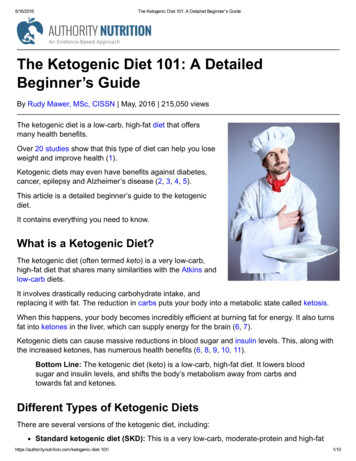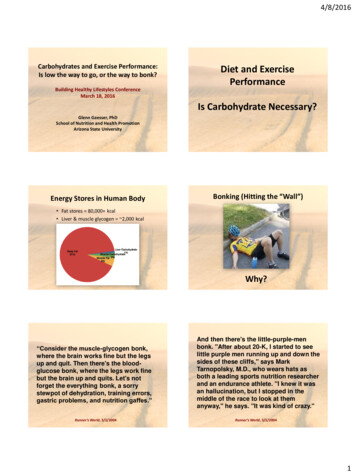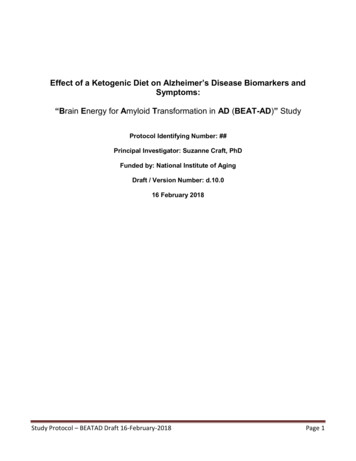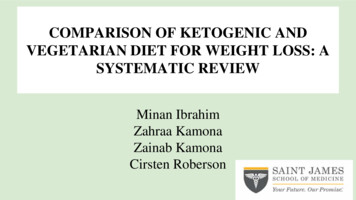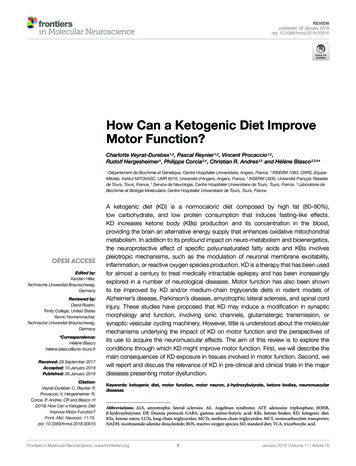
Transcription
Zinn et al. Journal of the International Society of Sports Nutrition (2017) 14:22DOI 10.1186/s12970-017-0180-0RESEARCH ARTICLEOpen AccessKetogenic diet benefits body compositionand well-being but not performance in apilot case study of New Zealand enduranceathletesCaryn Zinn* , Matthew Wood, Mikki Williden, Simon Chatterton and Ed MaunderAbstractBackground: Low-carbohydrate, high-fat and ketogenic diets are increasingly adopted by athletes for bodycomposition and sports performance enhancements. However, as yet, there is no consensus on their efficacy inimproving performance. There is also no comprehensive literature on athletes’ experiences while undertaking thisdiet. The purpose of this pilot work was two-fold: i. to examine the effects of a non-calorie controlled ketogenicdiet on body composition and performance outcomes of endurance athletes, and ii. to evaluate the athletes’experiences of the ketogenic diet during the 10-week intervention.Methods: Using a case study design, five New Zealand endurance athletes (4 females, 1 male) underwent a 10-weekketogenic dietary intervention. Body composition (sum of 8 skinfolds), performance indicators (time to exhaustion, VO2max, peak power and ventilatory threshold), and gas exchange thresholds were measured at baseline and at 10 weeks.Mean change scores were calculated, and analysed using t-tests; Cohen’s effect sizes and 90% confidence limits wereapplied to quantify change. Individual interviews conducted at 5 weeks and a focus group at 10 weeks assessedathletes’ ketogenic diet experiences. Data was transcribed and analysed using thematic analysis.Results: All athletes increased their ability to utilise fat as a fuel source, including at higher exercise intensities.Mean body weight was reduced by 4 kg SD 3.1 (p 0.046; effect size (ES):0.62), and sum of 8 skinfolds by25.9 mm SD 6.9; ES: 1.27; p 0.001). Mean time to exhaustion dropped by 2 min ( SD 0.7; p 0.004; ES: 0.53).Other performance outcomes showed mean reductions, with some increases or unchanged results in twoindividuals (VO2 Max: 1.69 ml.kg.min SD 3.4 (p 0.63); peak power: -18 W SD 16.4 (p 0.07), and VT2: -6 W SD44.5 (p 0.77). Athletes reported experiencing reduced energy levels initially, followed by a return of high levelsthereafter, especially during exercise, but an inability to easily undertake high intense bouts. Each athlete reportedexperiencing enhanced well-being, included improved recovery, improvements in skin conditions and reducedinflammation.Conclusions: Despite performance decrements and some negative experiences, athletes were keen to pursue amodified low-carbohydrate, high-fat eating style moving forward due to the unexpected health benefits theyexperienced.Trial registration: ACTRN: ACTRN12617000613303. Registered 28 April 2017, retrospectively registered.Keywords: Low-carbohydrate, high-fat, LCHF, Endurance athletes, Well-being, Performance* Correspondence: caryn.zinn@aut.ac.nzAuckland University of Technology (AUT). Sports Performance ResearchInstitute New Zealand (SPRINZ). AUT Millennium, 17 Antares Place, MairangiBay, Auckland, New Zealand The Author(s). 2017 Open Access This article is distributed under the terms of the Creative Commons Attribution 4.0International License (http://creativecommons.org/licenses/by/4.0/), which permits unrestricted use, distribution, andreproduction in any medium, provided you give appropriate credit to the original author(s) and the source, provide a link tothe Creative Commons license, and indicate if changes were made. The Creative Commons Public Domain Dedication o/1.0/) applies to the data made available in this article, unless otherwise stated.
Zinn et al. Journal of the International Society of Sports Nutrition (2017) 14:22BackgroundLow-carbohydrate, high-fat (LCHF) diets, including theirextreme version i.e., ketogenic diets have recently becomepopular dietary regimes for athletes for several reasons.However, there is no consensus regarding the efficacy ofketogenic diets on sports performance. The overarchingmainstream nutrition philosophy for endurance athletes,is one that emphasises a carbohydrate-dominant, low fatparadigm. Under these dietary conditions, athletes utilisecarbohydrate as their predominant fuel source to fuel highvolumes of aerobic exercise [1]. The appeal of LCHFeating for endurance athletes is likely due to the shift infuel utilisation, from a carbohydrate-centric model to onethat utilises fat predominantly, of which stores are unlimited compared to carbohydrate (i.e., muscle glycogen).This metabolic shift, seen after a period of dietary alteration is often referred to as being ‘fat-adapted’, which hasbeen well-documented in studies since the 1980s [2, 3].Despite the physiological advantage of utilising fat asa fuel source during sub-maximal exercise, to datethere is no conclusive evidence to suggest that thisresults in subsequent performance enhancement [4].Some individual responses to a ketogenic diet haveshown dramatic benefits in both fat metabolism andperformance, and are worth further investigation [5, 6].However, studies have also shown a reduction in maximal aerobic performance [7] with some evidence indicating a negative effect on exercise intensity 70% ofVO2 max [8, 9]. The majority of these studies have beencriticised for not being long enough to allow for the fulladaptive mechanisms to occur, which appear to requireat least 21 days.Despite the lack of peer-reviewed evidence for performance enhancement, athletes continue to be intrigued with the LCHF dietary paradigm. It is likely thatthis is the case for two reasons that go beyond the desireto obtain the extra performance edge: 1. a reduction inbody fat that is frequently cited when athletes undertakeLCHF or ketogenic diets [10], and 2. the anecdotalbenefits that are cited by athletes eating this way. Thereis very little athlete-specific literature, particularly of aqualitative nature, addressing non-performance outcomes of LCHF or ketogenic eating in an athlete cohort.In a translational case study design, this pilot study setout to investigate the effect of a 10-week ketogenic dieton body composition and performance outcomes in fiveNew Zealand endurance athletes, as well as to evaluate,qualitatively, the athletes’ experiences of undertaking theketogenic diet during their training season.MethodsStudy designThis was a pilot, 10-week intervention undertaken withfive case studies. A control group was not included.Page 2 of 9The study took place at AUT, Human Potential Centre;ethics was approved by the AUT Ethics Committee(application 15/415).ParticipantsFive recreational endurance athletes (four females, onemale) consented to participate in this study. All participants were known to the primary investigator and were allhighly motivated athletes regularly involved in high-levelcompetitive endurance sport for at least five years. All participants were non-smokers, healthy and injury-free as pera health screening questionnaire and not consuming a lowcarbohydrate diet (defined as carbohydrates less than 45%of total energy intake). See Table 1 for participant demographics. The athletes were curious about the efficacy ofthe ketogenic diet on their body composition and sportsperformance. None of them had any previous experiencewith, or pre-conceptions about low carbohydrate or ketogenic diets prior to this trial.Study protocolPrior to the start of the intervention, participants underwent a series of tests and a full consultation for dietaryinstruction and planning as follows:Performance test. Participants reported to the labin the morning in a fasted state and underwent aperformance test on three occasions: i. one week priorto the intervention (familiarisation), ii. immediatelyprior to the intervention (baseline), and iii. Immediately:post the intervention (post). To determine VO2peak andgas exchange thresholds (GET) an incremental cycletest was performed using an electromagneticallycontrolled cycle ergometer (Ergoselect 100, Ergoline,Bitz, Germany) in a temperature-controlled laboratory(21 C, 65% rH). The test commenced at 30 W andincreased by 30 W every 3 min until volitionalexhaustion. Participants were instructed to maintain: acadence of 80 revolutions.min 1. Oxygen uptake (VO2 )was measured continuously using a breath-by-breathmetabolic system (Metamax 3b, Cortex, Leipzig,Germany), and heart rate was continuouslymeasured using a short-range telemetry device:(Suunto M2, Suunto, Vantaa, Finland).The VO2peak:was defined as the highest 30s VO2 value and theGET was identified independently by two experiencedinvestigators using the V-slope method [11].Dietary instruction. An initial consultation wasconducted with each participant by the primaryresearcher/Registered Dietitian directly after theperformance test. Participants were provided with adaily macronutrient prescription of 50 g total
Zinn et al. Journal of the International Society of Sports Nutrition (2017) 14:22Page 3 of 9Table 1 Participant demographicsParticipantSexMain sportTraining volume(hours/week)Age (yr)Weight (kg)Height (cm) 8 Skinfolds eCycling6–85560.8158.0118.3carbohydrate, 1.5 g.kg protein and ad libitum fat.A detailed explanation of the practical applicationof the ketogenic dietary principles along withappropriate tracking and monitoring procedureswas provided. Participants were provided witha sample diet and were advised to add variations aslong as they adhered to the carbohydrate andprotein macronutrient thresholds.They were instructed to track their diet using adietary analysis programme Easy Diet Diary (Xyris Software (Australia) Pty Ltd). Diets weremonitored weekly by the primary researcher, andparticipants were contacted and offered additionalsupport if they deviated. The primary researchermaintained regular contact with all participantsthroughout the 10-week study duration.Exercise instruction. The participants were allseasoned athletes, and participated on a regular basisin endurance events, i.e., mountain biking, road biking,running and multisport events (which includedrunning, cycling and kayaking), both recreationallyand competitively. Hence, their training protocols didnot vary much from month-to-month. They wereinstructed to continue with their existing trainingvolumes for the duration of the intervention.Ketone blood testing. Each participant was shownhow to measure blood ketone levels via fingerprick, and provided with a FreeStyle Optiumketone meter and ketone strips. They wereinstructed to measure their blood ketone levelsdaily between 2 pm and 4 pm. Nutritional ketosis wasdefined as a blood ketone (beta-hydroxybutyrate)level 0.5 mmol/l.( ) 8-site skinfold ISAK protocol was applied: triceps,biceps, subscapular, iliac crest, supraspinale, abdominal,front thigh and medial calf [12].Interviews and focus group. A 20–30 min individualinterview was conducted on the phone during week5 week and a 60-min focus group was conducted inperson once the intervention had concluded. Theimportance of this qualitative work was to assess boththe individual and the groups’ overall experiencesof being on this diet for 10 weeks. The group sessionprovided a chance for athletes to compare experiencesand translate findings to future practice.Data analysisDue to the explorative nature of this study, and oursmall sample size, quantitative data is presented as individual responses. Data was analysed using mean changescores, with Cohen’s effect sizes and associated confidence limits applied to quantify magnitude of change.We also elected to apply a probability statistic using astudent’s t-test to determine the statistical meaning ofthe change. All statistics were generated and appliedusing Microsoft Excel 2016. We acknowledge that applying statistical models hold limited meaning in thiscontext and it is not our intention to make any inferences about these outcomes to athlete populations. Assuch, outcomes with a significance level of p 0.05should be considered a trend only; and p 0.01 significant only in the sense that further work is required tosubstantiate these findings. Interviews and the focusgroup were recorded and transcribed, after which datawas analysed using thematic analysis. The data for theinterviews and focus groups were combined and is presented as key themes with supporting transcripts.ResultsDiet and ketosisAnthropometric testing. Body weight and skinfoldswere measured by an ISAK level one accreditedanthropometrist, prior to and at the conclusion ofthe intervention, at the same time of the day. A sum ofThe diets were geared to induce nutritional ketosis,which all the athletes achieved by the end of week 2. Allathletes adhered to the macronutrient thresholds provided for the 10 weeks, apart from on two occasions
Zinn et al. Journal of the International Society of Sports Nutrition (2017) 14:22during the first two weeks, once, where protein intakeexceeded the recommended threshold over several daysin one athlete and alcohol intake was excessive inanother athlete, thereby preventing ketosis from beingachieved. Table 2 presents an example of a day’s foodintake for each participant along with the average energyand macronutrient breakdown for that day. The sampleday was selected at random during week 5. The athletesvaried little from the sample diets provided to themthroughout the 10 weeks, with adherence to the dietsverified by blood ketones always staying above0.5 mmol/l from week 2 onwards. Blood ketones rangedfrom 0.5–4.2 mmol/l; females ranged 0.5–1.9 mmol/l,and never exceeded 1.9 mmol/l. The male athlete ranged1.0–3.5 mmol/l, went below 1.0 mmol/l on two occasions (0.8 and 0.6 mmol/l) and measured 4.2 mmol/l onone occasion.Substrate oxidationFigure 1 presents the pre and post intervention fuel utilisation (also termed metabolic efficiency) curves, alongwith associated peak fat oxidation (g/min) and fat max(%Wmax) for each participant.Each curve displays the cross-over point i.e., the pointat which peak fat oxidation is reached, and the point atwhich carbohydrate takes over as the predominant fuelsource. Mean peak absolute fat oxidation and standard deviation (SD) increased by 41.3% (0.6 0.1 to0.8 0.1 g.min 1, p 0.001). All of the athletes increased their peak fat oxidation. The exercise inten:sity relative to VO2 max at which peak absolute fatoxidation occurred (Fatmax) increased by 31.2% frompre- to post-intervention (48.2 8.7 to 63.2 5.7%:VO2 max , p 0.06). Similarly, Fatmax relative to WRmaxincreased by 21.5% from pre- to post-intervention(39.5 11.9 to 48.0 8.9%WRmax, p 0.18). Twoout of the five athletes showed an increase in Fatmaxrelative to WR max, and the remaining three showedno change.Body composition/performanceFigure 2 shows individual pre and post scores for anthropometric and performance data. All five participantshad reductions in body weight and skinfolds. The meanloss in weight and SD was 4.0 3.1 kg (p 0.046), andin skinfolds was 25.9 6.9 mm (p 0.001). The skinfold outcome showed a large effect size (1.27) with associated confidence limits not crossing zero, togetherindicating clinical significance in the context of theirlimited application to this data.All participants showed a decrease in time to exhaustion (TTE), the mean time and SD reduction was2 0.7 min (p 0.004). More varied responses werePage 4 of 9noted in the change in VO2 Max (mean change 1.69 3.4 ml.kg.min (p 0.63)), peak power (meanchange 18 16.4 W (p 0.07)) and ventilatory threshold, VT2 (mean change 6 44.5 W (p 0.77)), withsome athletes improving (VT2 and VO2 max) or stayingthe same (VT2 and peak power).Athlete experiencesTable 3 presents the key positive and negative themesextracted from the focus group. Overall, there weremore positive themes than negative; with an improvedsense of general health and well-being coming throughas a strong theme. The majority of the negative experiences related to tiredness, experienced in the first fewweeks of the intervention, and a feeling of loss of power,experienced towards the last few weeks. Each athlete reported the following subjective parameters: enhancedwell-being, improved recovery, improved skin conditionsand reduced inflammation.DiscussionThis study presents a real-life insight into the lives offive seasonal endurance athletes who by virtue of theirown curiosity wished to experience the effects of a ketogenic diet on their sports performance. Overall, participants were able to increase the substrate utilisation offree fatty acids, reduce body fat and experience positivehealth benefits, but their maximal aerobic performancewas compromised.Body compositionThe reduced body fat can likely be explained by a resultant calorie deficit created by the diet, as participants reported enhanced feelings of satiety and a reduction inoverall food intake. This outcome was unsurprising andcomparable to findings in previous research on bothstrength and endurance athletes [13–15]. Initial weightreduction can be associated with a loss in body waterthrough glycogen depletion, [16, 17], and this was alsolikely the case in this study; however fat loss was evidentas per skinfold changes. A further theory relating toweight loss, which is as yet, rigorously tested, is an increased drive for fat breakdown rather than storage ascirculating levels of insulin remain low during ketogenicdiets [18]. Perhaps a combination of all three mechanisms can explain the weight loss. A limitation of thestudy was a lack of energy comparison prior to, andduring the study, which would have provided someclarity about these mechanisms.Metabolic efficiencyAll participants had a greater fatty acid oxidation at ahigher given intensity at the end of the trial compared tobaseline. This finding of enhanced fat utilisation aligns
Lunch125 g smoked salmon, 2 egg muffinsb,100 g avocadoLunchSalad: spinach leaves, ¼ avocado,30 g Gruyere cheese, 60 g salmon,spring onion, 1 T avocado oil, ½ cupsliced almondsLunch1 egg muffin, 100 g avocado, dessertspoon peanut butter, square chocolateLunch95 g tin tuna, avocado, cheese,1 T olive oilLunchSalad: 1 cup mesclun leaves, ½ avocado.30 g feta cheese, 90 g chicken, 6 babytomatoes, 50 g cucumber, 30 g celery,2 T olive oilEnergy 1406Cal; Net carbohydrate 19 g; Protein 93 g (1.5 g/kg); Fat 103 gBreakfast2-egg omelette (spinach, mushroom)cooked in 2 tsp. butterEnergy 1919Cal; Net carbohydrate 31 g; Protein 96 g (1.5 g/kg); Fat 154 gBreakfast½ cup granolaa, 150 ml Greek yoghurt,50 g mixed frozen berriesEnergy 1768Cal; Net carbohydrate 33 g; Protein 76 g (1.1 g/kg); Fat 131 gBreakfast½ cup granola, 125 ml coconut cream,50 g mixed frozen berriesEnergy 1710Cal; Net carbohydrate 9 g; Protein 94 g (1.5 g/kg); Fat 128 gBreakfast3 rashers bacon, 2 eggs scrambled in1 T coconut creamEnergy 2450Cal; Net carbohydrate 24 g; Protein 103 g (1.4 g/kg); Fat 215 gBreakfast½ cup granolaa, 150 ml coconut cream,100 g mixed frozen berries,30 ml coconut oilcbgranola was made in a batch and consisted of a range of nuts, seeds, coconut threads and coconut oilegg muffinsT tablespoondtsp. teaspoonaParticipant 5(female)Participant 4(female)Participant 3(female)Participant 2(female)Participant 1(male)Table 2 Participants’ dietary data and macronutrient compositionDinner120 g fish, stir-fry vegetables (1 mediumzuchini, 50 g broccoli, 5 mushrooms,½ brown onion), cooked in 1 T olive oilDinner100 g chicken with skin, 1 tsp. soy sauce,1 cup cauliflower, 25 g leek, 50 gasparagus, 1 T butterDinner100 g pork straps, 70 g spinach, 1 cupcauliflower rice, 1 T butter square 85%dark chocolate 180 ml red wineDinner100 g rump steak, salad (spinach,spring onion, pepper, carrot,desiccated coconut, 1 T pumpkin seeds),2 tsp.d pestoDinner120 g fish cooked in 1 Tc olive oil,80 g broccoli, ½ cup almonds,50 g feta cheeseSnacks100 ml coconut cream; 30 g almonds;waterOther30 g salami; ½ cup almonds; coffee,150 ml milk; 100 ml coconut cream,waterOtherCoffee, 100 ml soya milk; green tea;1 strawberry; 20 g ham; 30 g almonds;waterOther40 g blue cheese; 180 ml red wine;herbal tea; waterOther2 X Coffee (60 ml cream)WaterZinn et al. Journal of the International Society of Sports Nutrition (2017) 14:22Page 5 of 9
Zinn et al. Journal of the International Society of Sports Nutrition (2017) 14:22Page 6 of 9Fig. 1 Pre, and post intervention metabolic efficiency curves for each participant. * PFox: Peak Fat Oxidation (g/min). † Fatmax: Maximum fatoxidation at % WRmaxwith those of several other groups that have incorporated ketogenic and non-ketogenic dietary protocols[5, 19, 20]. Furthermore, this substrate utilisationalteration can be attributed to the change in diet astraining was kept relatively consistent throughout theintervention. Our participants also had a higher oxygen cost at sub-maximal workloads due to the higheruse of fat as an energy substrate. However, this didnot benefit exercise capacity.PerformanceOn the whole, maximal aerobic performance was reduced, another comparable outcome to similar research[21–23], the exception being one athlete in Phinney etal.’s 4-week cycling study [5], and Zajac et al.’s eight offroad cyclists [6], who all showed performance increases.The performance decrement in our study, and others, islikely due to changes in metabolic pathways that impairglycogen metabolism at higher exercise intensities
Zinn et al. Journal of the International Society of Sports Nutrition (2017) 14:2280140ES*: 0.62 [CL†: -0.38;1.25]120Skinfolds (mm)Weight (kg)757065601005560400PrePostPre60ES: 0.53 [CL: -0.53; 1.59]VO2max (ml/kg/min)3432TTE (min)80205036ES: 1.27 [CL: 0.13; 2.41]30282624PostES: 0.20 [CL: -0.85; 00PrePostES: 0.11 [CL: -0.93; 1.16]Peak Power (W)VT2 ES: 0.40 [CL: -0.65; 1.45]Page 7 of 9replete muscle glycogen stores between groups. Authorssuggest a homeostatic muscle glycogen repletion mechanism arising from hepatic gluconeogenesis, which mightserve to provide clues into why many athletes report optimal performance, anecdotally, when having eaten in anLCHF manner for extended periods of time. While this isa plausible speculation, a similar study by Webster et al.,[20] showed no difference in gluconeogenic rates duringexercise in fasting LCHF and mixed-diet athletes. In fact,glucose was produced endogenously to a greater extent inthe mixed diet group, and was attributed to greater ratesof hepatic glycogenolysis. Researchers concluded that gluconeogenesis during exercise may remain stable across arange of dietary regimes after an overnight fast, but thathepatic glycogenolysis is influenced by dietary carbohydrate. Further exploration of fuel contributions to gluconeogenesis and the effect of different feeding protocols onendogenous glucose producing mechanisms is warranted.It is important to note that both of these studies did notincorporate a performance measure, leaving the questionsto this key issue unanswered [19, 20].Athlete experiencesPrePost* ES: Effect sizeCL: Confidence LimitsData overlap for two athletesFig. 2 Individual responses and effect sizes of anthropometry andperformance variables[24–26]. Specifically, a down-regulation of the carbohydrate oxidative enzyme, pyruvate dehydrogenase (PDH),which via conversion of pyruvate to acetyl-coenzyme A,links the glycolytic pathway with the Krebs cycle [27].PDH is said to be reduced rapidly through a reduction incirculating insulin and an increase in circulating levels offree fatty acids [28]. Evidence suggests that PDH is upregulated upon carbohydrate reintroduction [25]; however,there is little insight into its fate along with other mitochondrial enzymes in the context of low carbohydrateavailability. Despite similarities in findings with otherstudies, some of these studies are limited by shortduration low carbohydrate diets [28–30]. Future researchwith chronically fat-adapted athletes is needed to investigate these micro-level mechanisms alongside performanceoutcomes. Recently, Volek et al.’s work [19] with chronically fat-adapted ultra-endurance athletes ( 6 months) notonly demonstrated a 2.3 times greater fat oxidation rate inthe LCHF group compared with the mainstream dietarygroup, but also demonstrated no difference in resting andThis is one of the few studies to report specifically onendurance athletes’ experiences of undertaking a ketogenic diet. Athletes reported similar negative physiological experiences to those reported by athletes incomparable ketogenic diet studies [13, 14, 31]. However,they also reported experiencing benefits throughout thetrial. One of these benefits was enhanced recovery;possibly, the rise in blood ketones had some influence,as beta-hydroxybutyrate has been associated with upregulating antioxidant gene expression and decreasingreactive oxygen species [32]. However, further research is required to substantiate this within athleticpopulations.From a physical well-being perspective, the cases of improved skin, and the resolution of an ongoing prostate issue,were major points of discussion of benefits experienced. Wespeculate that it is the reduction of systemic inflammationas a result of a lower total sugar [33] and Omega 6 fatty acidintake, thereby rebalancing the Omega 6:3 fatty acid ratio inan anti-inflammatory direction [34] that gave rise to theseoutcomes. All participants were consuming high-Omega 6industrial seed oils prior to the study (used as cooking fatand derived from processed foods). During the study thesefats were replaced with coconut oil, butter and olive oil;i.e., fats containing minimal Omega 6 fatty acid content.Being a translational study, we followed up participants informally 12 months after the study concluded.They were all still competing in endurance events, andwhile not eating a ketogenic diet, none of them hadreturned to their previous high carbohydrate, low fatstyle of eating. Collectively, they reported that once the
Zinn et al. Journal of the International Society of Sports Nutrition (2017) 14:22Page 8 of 9Table 3 Themes from interviews and focus group with supporting transcriptsPositive themesNegative themesPhysical recoveryLoss of power during exercise/training“The recovery each time was amazing. I would go for a 4–5 h runthen be able to mountain bike the next day, just to be able to do itwithout sore muscles”.“The next day after a 4-h run I could have got up and done itagain - my legs weren’t tired or sore”.“Certainly I’ve had the recovery benefits I felt fine to go out the nextday and do stuff I didn’t feel the muscle soreness I would haveexpected”.“I don’t feel sore”.“I was surprised that I could run comfortably for that long so I thinkthe recovery was huge I never felt this, it’s unheard of”Enjoyment of this way of eating“It’s given me the freedom to eat the things that I stopped eating fora long time because I thought it was a no-no”.“Not feeling hungry has been amazing”. (X2)“Not being bothered about food, you know food doesn’t bother meanymore, as before I had a meal and 3 h later I’d feel irritable ifI didn’t eat”.“It’s been fantastic for me having food I couldn’t for a long time andI really enjoy it, the flavour, for me the reason why I want to carry onwith this way of eating is because I actually enjoy it, I enjoy it farmore than my previous diet”.“It was embarrassing to the point where I just got to the pointwhere you just don’t have any energy”. (weeks 1–5)“I got too tired and I got to the point where I might have had somebig runs, 4 or 5 h runs and wake in the night before hand, worriedabout it. I’d think, how am I going to do that tomorrow it’s going tobe hard”. (weeks 1–5)“The lack of power, I just couldn’t get up the hill.” (weeks 6–10)Negative symptoms (weeks 1–3)“I hadn’t been for 4 days and I was starting to get bound up”.(constipation).“One of the downsides is that I had cramps, massive cramps”.“I may have seemed a bit irritable for a while. People close to merealised I was down and I’m pretty good at hiding that but peoplepicked it up”.Food regime boredom“Bored with the food regime, actually I’m back on fruit ”“ but I am starting to get sick of the diet plan”.“You can’t even free load in your veggies.”Weight management“Being able to shed that 5 kg was definitely a benefit”.“The benefit now of me being able to understanding how to managemy weight, that’s been a real effect, actually that’s been for all of us”.Feel better overall (well-being)“My skin hasn’t been this good since I can remember”.“My prostate, a million times better because I can sleep”.“The other thing I noticed is my tinnitus is a lot better, I can’t hearthe ringing in my ears I used to have”.“Just general health - I just feel better, I need less sleep”.“I noticed that I didn’t fart for 2 months, no gas”.“Yes, no gas, that’s the same as me.”“I feel sharper mentally”.“Food used to dictate my moods, and now it doesn’t”.“Positive skin, I have a facial every 6 weeks, I didn’t tell the facial ladywhat I was doing and she said to me what’s happened to your skin?No extractions in the last 8 weeks, no blockages”.study concluded they gradually increased their carbohydrate intake until the point at which they felt their performance at high intensities return. They were stillrestricting carbohydrate and eating more fat than mainstream guidelines recommend, and reported having discovered the optimal macronutrient ratio that satisfied aperformance, body composition and a health goal.This study had several limitations: Its design as a pilotcase study, with no standardisation of training preventsany inference from being made to athletic populations.However, it is still relevant to both the researcher and thepractitioner as it provides insights into what is
diet on body composition and performance outcomes of endurance athletes, and ii. to evaluate the athletes' experiences of the ketogenic diet during the 10-week intervention. Methods: Using a case study design, five New Zealand endurance athletes (4 females, 1 male) underwent a 10-week ketogenic dietary intervention.
